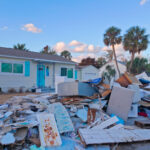There’s something very human about attempting to master nature itself. We live in an uncertain time, however — one in which unpredictable weather patterns make it increasingly difficult to protect our property and communities from severe and destructive storms fueled in part by the climate. This classic push-and-pull — the uncertainty of nature, coupled with the human desire to resist and defend against the elements — is illustrated in three emerging risks.
The growing danger of destructive convective storms, and the latest advancements in battery energy storage and drone technology are three risks insurers should keep an eye on as severe weather increases.
The Rising Threat of Convective Storms
The high winds and heavy rains that accompany powerful convective storms can endanger countless lives, and often carry a heavy price tag for businesses and property owners. These dangers often reverberate throughout the insurance industry. For example, according to Verisk’s 2024 Executive Insights: Homeowners report, wind and hail together averaged 62% of total homeowners catastrophe losses in 2023.
Convective storms — which form when heat and moisture are vertically transported into the air — have increased approximately 7% annually over the past 30 years, according to a recent report, and forecasters are predicting similarly volatile weather patterns in the U.S. for the remainder of 2024.
Compounding these risks to property and personal safety are the rising temperatures and weather patterns associated with the ongoing climate crisis. Changes in ocean temperatures have likely contributed to an increase in the frequency and severity of high-wind storms like hurricanes, thunderstorms and tornadoes.
A recent study published in the Journal of Applied Meteorology and Climatology, for instance, found that tornadoes are increasingly likely to form in colder weather and in pockets of the country outside of the central Plains states — effectively shifting “Tornado Alley” eastward.
And unfortunately, convective storms are affecting areas most vulnerable to property damage. According to a 2023 Verisk analysis, roof conditions tend to be the poorest where hail or wind events are the most frequent and severe.
Property damage isn’t the only risk from these storms. Power outages from severe storms have doubled across the United States over the past two decades, rising from approximately 50 to more than 100 annually in the past few years. The frequency and duration of these outages have also increased, according to the same report. These outages can affect people’s lives and businesses and disrupt access to medical services, clean water, heating, cooling, and food.
For homeowners, these storms can entail a convective double-whammy: costly damage from high winds and hail plus flooding from potential sump pump failures prompted by grid outages.
Surge in Battery Storage Increases Fire Risk
Many Americans are turning to a tried-and-true option to help contend with changing weather patterns and an ever-increasing demand for energy: the battery.
Battery energy storage systems, or BESS, have grown sharply in popularity in recent years and are projected to continue growing through 2024. The U.S. Energy Information Agency (EIA) expects capacity for these lithium battery-powered systems to double in the U.S. this year, after growing by a whopping 70% from 2022 to 2023.
But these lithium battery energy storage systems invite potential concerns, with fire risk being chief among them. In 2019, for example, four firefighters were seriously injured battling a blaze at a BESS in Arizona — just one of several blazes linked to these systems in recent years. For commercial property insurers, the prospect of a BESS fire could mean damage both to the unit itself and to any property near enough to the flames or flying debris. Similar fire concerns hang over residential storage systems, though research to date indicates that commercial and residential BESS account for a small fraction of lithium-ion battery fires.
One additional challenge may loom even larger for residential users: cost. According to available estimates, a BESS could run homeowners anywhere between $12,000 and $22,000, depending on the technology, which might influence the overall value of the insured property.
Are Drones Ready for Takeoff?
Recent updates to federal regulation regarding unmanned aerial systems (UASs) — more commonly known as drones — coupled with a spike in recent years of commercial drone registrations, suggest that drones are poised to impact a wide variety of industries, and bring potential exposure to insurers.
In 2019, for example, 385,000 small commercial UAS were registered with the FAA. Five years later, that number has more than doubled to 842,000. The FAA expects the trend to continue. By 2028, it predicts the number of small, unmanned aircraft to reach 1.1 million.
Drone versatility is evident in the many recreational and commercial use cases. They can map wildfires, measure wind speeds, and survey damage from tornados and hurricanes. In other instances, drones have been used to respond to 911 calls, entertain crowds at light shows, and remove trash from the world’s tallest mountain. In many cases, drones have replaced laborious and time-consuming tasks for workers with a safer and lower-cost solution.
Drones already play a key role in the energy, construction and agricultural sectors. In March, for instance, the FAA approved an exemption waiver by one Texas-based drone manufacturer to “swarm” up to three drones carrying payloads above 55 pounds, potentially paving the way for scaled application across U.S. farmland.
The technology is not without potential risks.
One study, for example, examined U.S. emergency department visits and found there was an increase in drone-related injuries between 2010 and 2017. Recent examples include a teenager who was hospitalized after an accident in Florida and a Taiwanese actor who was injured after a drone with a camera hit his face.
As these weather, energy and technology risks expand, insurers need to monitor the impact on their book of business this year and beyond.
Was this article valuable?
Here are more articles you may enjoy.


 Don’t Forget Tariff Impacts on Workers’ Compensation: Berkley
Don’t Forget Tariff Impacts on Workers’ Compensation: Berkley  Pet Insurance, Agents Gets a Shorter Leash Under Bill DeSantis Signed Into Law
Pet Insurance, Agents Gets a Shorter Leash Under Bill DeSantis Signed Into Law  More Floridians Moving Out Due to Housing, Insurance Costs, Cotality Report Says
More Floridians Moving Out Due to Housing, Insurance Costs, Cotality Report Says  Dog Bite Claims Soar in Frequency and Cost: Report
Dog Bite Claims Soar in Frequency and Cost: Report 



